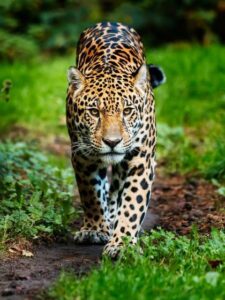The jungles of the world are home to some of the most fascinating and diverse creatures on the planet. From the dense rainforests of the Amazon to the lush forests of Southeast Asia, these incredible ecosystems provide shelter to countless species. Here, we will explore five of the most amazing jungle animals that captivate scientists and nature enthusiasts alike.
1. Jaguar (Panthera onca)
The jaguar is the third-largest big cat in the world and the largest in the Americas. Known for its powerful build and striking spotted coat, this majestic predator roams the dense forests of South and Central America, particularly the Amazon rainforest. Jaguars are solitary animals and are known for their incredible strength, often dragging prey much larger than themselves up into trees.

One of the jaguar’s most remarkable traits is its bite force, which is the strongest of any big cat relative to its size. Unlike other big cats that kill their prey by biting the throat, jaguars use their powerful jaws to crush the skulls of their victims. This adaptation allows them to hunt a wide variety of prey, including capybaras, caimans, and even anacondas.

Jaguars play a crucial role in maintaining the health of the jungle ecosystem by regulating prey populations. However, due to habitat loss and poaching, jaguar populations are declining, making conservation efforts vital for their survival.
2. Harpy Eagle (Harpia harpyja)
The harpy eagle is one of the largest and most powerful eagles in the world. Found in the tropical rainforests of Central and South America, this impressive bird of prey is known for its striking appearance, with a large wingspan, black-and-white plumage, and a distinctive feathered crest on its head.

Harpy eagles are apex predators and primarily hunt tree-dwelling mammals such as sloths and monkeys. They have incredibly strong talons, which can exert enough pressure to crush bones, making them formidable hunters. Despite their size, harpy eagles are agile flyers, capable of maneuvering through dense forest canopies in pursuit of prey.

Unfortunately, habitat destruction due to deforestation poses a significant threat to harpy eagle populations. Conservationists are working to protect these magnificent birds by preserving their rainforest habitats and educating local communities about their importance in the ecosystem.
3. Poison Dart Frog (Dendrobatidae family)
Among the most vibrant and colorful inhabitants of the jungle, poison dart frogs are tiny yet incredibly toxic amphibians found in Central and South America. Their bright colors serve as a warning to predators that they are highly poisonous. The level of toxicity varies between species, with some capable of producing enough poison to kill multiple humans.

These frogs derive their toxicity from their diet, which consists of ants, termites, and other small insects. Indigenous tribes have historically used the poison from certain dart frog species to coat their blowgun darts for hunting, giving these frogs their name.

Despite their toxic defense mechanisms, poison dart frogs are vulnerable to habitat loss and climate change. Many species are now endangered, highlighting the need for conservation efforts to preserve their rainforest habitats.
4. Anaconda (Eunectes genus)
Anacondas are among the largest and most powerful snakes in the world. The green anaconda (Eunectes murinus), found in the swamps and rainforests of South America, is the heaviest snake on the planet and can grow up to 30 feet in length and weigh over 500 pounds.

Unlike venomous snakes, anacondas are constrictors, meaning they subdue their prey by coiling around it and squeezing until it suffocates. They primarily hunt in water, preying on fish, birds, caimans, and even jaguars in rare cases. Their eyes and nostrils are positioned on top of their heads, allowing them to remain almost entirely submerged while stalking their prey.

Anacondas play a crucial role in their ecosystems by controlling populations of prey species. However, habitat destruction and hunting for their skins threaten their survival. Conservation efforts aim to protect these incredible snakes by preserving their natural habitats and educating people about their ecological importance.
5. Orangutan (Pongo genus)
The orangutan, found in the rainforests of Borneo and Sumatra, is one of the most intelligent primates on Earth. Known for their reddish-brown fur and remarkable problem-solving abilities, these great apes share approximately 97% of their DNA with humans. They are highly skilled at using tools, such as sticks to extract insects from trees or leaves to protect themselves from rain.

Orangutans are solitary animals, spending most of their time in trees, where they build nests from branches and leaves to sleep in. Their diet consists mainly of fruit, but they also eat leaves, bark, and small insects. Due to their slow reproductive rate—females only give birth once every 7-9 years—orangutans are highly vulnerable to population declines.

Unfortunately, habitat destruction due to deforestation and illegal wildlife trade has led to a drastic decrease in orangutan populations. Conservation organizations are actively working to protect their habitats and rehabilitate orphaned orangutans, ensuring their survival for future generations.
Conclusion
The jungle is home to some of the most extraordinary and diverse animals on the planet. Jaguars, harpy eagles, poison dart frogs, anacondas, and orangutans are just a few examples of the incredible wildlife that thrives in these dense and vibrant ecosystems. However, many of these species face significant threats due to habitat destruction, climate change, and human activities. By supporting conservation efforts and promoting sustainable practices, we can help protect these amazing jungle animals and preserve the natural beauty of our planet for future generations.









